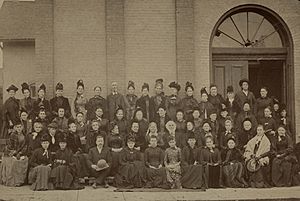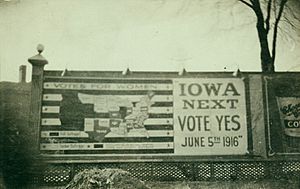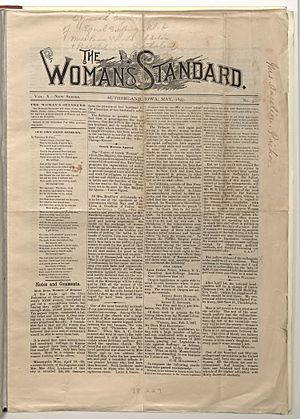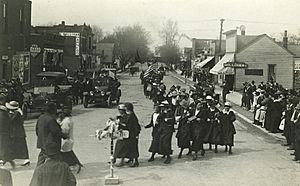Timeline of women's suffrage in Iowa facts for kids
This is a timeline showing when women in Iowa gained the right to vote. The fight for women's suffrage, which means the right to vote, started very early in Iowa's history. People began organizing in the late 1860s. The first big meeting about women's voting rights happened in 1870.
By the 1890s, women in Iowa could vote on some local issues. These included decisions about city bonds, taxes, and school matters. In 1916, a plan to change the state constitution to allow women to vote was put to a public vote. Sadly, it did not pass. However, Iowa was one of the first states to approve the 19th Amendment in 1919. This important amendment gave women across the entire United States the right to vote!
Contents
The Fight for the Vote: 19th Century
Early Discussions: 1840s-1850s
1843
- The Iowa State Legislature, which is like the state's law-making group, talked about women's voting rights. They also discussed other issues important to women.
1844
- During a special meeting to write the state's constitution, people discussed who should be allowed to vote. They talked about voting rights for both African Americans and women.
1854
- Frances Dana Barker Gage gave speeches in Oskaloosa about women's rights, including the right to vote.
1855
- Amelia Bloomer was the first person living in Iowa to publicly talk about women's suffrage in the state.
1857
- Iowa's state constitution was written to only allow white men to vote. Women's suffrage was still a topic of discussion during these meetings.
Organizing for Change: 1860s
1866
- Women who supported suffrage in Clinton County asked the state government to support a change to the state constitution. This change would give women the right to vote.
- However, the bill for women's suffrage did not pass in the Iowa state senate.
1868
- November 3: A big step forward happened! The word "white" was removed from the state constitution's description of a voter. This change came after a successful public vote.
1869
- Mary Newbury Adams started a group called the Northern Iowa Woman Suffrage Association (NIWSA). This group worked to get women the right to vote.
First Conventions and Votes: 1870s
1870
- March: A bill to change the state constitution for women's suffrage passed for the first time. It needed to pass again in 1872 to move forward.
- June 16-17: The very first statewide meeting about women's suffrage was held in Mount Pleasant. At this meeting, the Iowa Equal Suffrage Association (IESA) was formed.
- October 25: The Polk County Suffrage Society was also created to support voting rights for women.
1871
- The voter registration board in Clarinda added women's names to the voter list. But most of these names were later removed.
- Keziah Anderson Dorrance cast her vote in Taylor County. Friendly judges said her vote was valid, making her the first woman to vote in Iowa!
- October: The state suffrage convention was held in Des Moines.

1872
- The suffrage bill, which needed to pass a second time, did not succeed this year.
1873
- March: Another state suffrage convention was held.
1874
- The Republican Party in Iowa promised to work towards a women's suffrage amendment.
1876
- Both the Iowa Governor and the state House of Representatives supported a suffrage amendment.
1877
- The Iowa chapter of the Woman's Christian Temperance Union (WCTU) announced their support for women's suffrage. They did this during their meeting in Ottumwa.
Growing Support: 1880s
1884
- A women's suffrage bill passed in the state Senate. However, it did not pass in the state House of Representatives.
- November 27–28: The state suffrage convention was held in Des Moines.
1885
- October 21–22: The state suffrage convention took place in Cedar Rapids.
1886
- A bill that would allow women to vote in city elections was suggested. But it was not put to a full vote.
- The state suffrage convention was held in Ottumwa.
- September: A newspaper called Woman's Standard was started. Mary Jane Coggeshall and Martha C. Callanan were its editors.
1887
- The state suffrage convention was held in Des Moines.
1888
- The state suffrage convention was held in Ames. Famous suffragist Susan B. Anthony spoke at this event.
- People who were against women's suffrage held a parade in Davenport.
1889
- October 30-November 1: The state suffrage convention was held in Oskaloosa. Henry Browne Blackwell and Lucy Stone, two important suffrage leaders, attended.
- November: Carrie Chapman Catt started the Political Equality Club of Sioux City. She would become a very important leader in the national suffrage movement.
Partial Victories: 1890s
1890
- Governor William Larrabee spoke in favor of giving women some voting rights.
1891
- November 7: The Iowa Equal Suffrage Association (IESA) officially became a recognized organization.
- December 3–4: The state suffrage convention was held in Ames.
1892
- A bill was proposed to let women vote for the President. But it did not get out of the committee stage.
- September 22: The state suffrage convention was held in Des Moines.
1893
- November 9–10: The state suffrage convention was held in Webster City.
1894
- February: Two bills were introduced in the Iowa State House and Senate. These bills aimed to give women partial voting rights.
- March 22: A bill that combined voting rights for city and school issues, called the Watkins Bill, passed in the state House.
- April 13: Women who paid taxes gained some voting rights! They could now vote on bond issues and for school-related matters. This was a big step forward.
- November 8–9: The state suffrage convention was held in Marshalltown.
- Women in Waterloo came together to vote and support a tax for the city library.
1895
- October 18–19: The state suffrage convention was held in Des Moines.
1896
- Pauline Swalm talked about the Woman Citizen newspaper at the Iowa State Fair.
- November 17–19: The state suffrage convention was held in Independence.
1897
- January: The National American Woman Suffrage Association (NAWSA) held its yearly meeting in Des Moines.
- April 2–3: Anna Howard Shaw, a famous suffrage leader, spoke in Jefferson about women's voting rights.
1898
- February 23: The Iowa Association Opposed to Woman Suffrage (IAOWS) was formed. This group worked against women getting the right to vote.
The Final Push: 20th Century
New Century, New Efforts: 1900s
1900
- More than 100,000 signatures asking for women's suffrage were sent to the state legislature.
- May: The Iowa Federation of Colored Women's Clubs (IFCWC) was started. Helen Downey was its first president.
1901
- November: The yearly state suffrage convention was held in Waterloo.
1902
- A women's suffrage law passed in the state Senate but failed in the House.
- October: The state suffrage convention was held in Des Moines.
1903
- October: Boone hosted the state suffrage convention.
1904
- October: The state suffrage convention was held in Sheldon.
1905
- November: The state suffrage convention was held in Panora.
1906
- September: The yearly state suffrage convention was held in Ida Grove.
1907
- October: The state suffrage convention was held in Des Moines.
1908
- October: The state suffrage convention was held in Boone.
- October 29: A suffrage parade was organized in Boone by Rowena Edson Stevenson and Eleanor Gordon. About 150 women marched and then listened to a speech by Anna Howard Shaw.
- November: Women voters were not given ballots during a bond election in Des Moines, even though they had partial voting rights.
The Home Stretch: 1910s
1910
- About 79 men started the Iowa chapter of the Men's League for Woman Suffrage. This showed that not only women supported the cause.
1911
- The Iowa Woman's Christian Temperance Union (WCTU) publicly announced their support for women's suffrage.
- The Iowa Federation of Women's Clubs (IFWC) also declared their support for suffrage during their meeting in Sioux City.
- The Woman's Standard newspaper stopped being published.
- December 22: Mary Jane Coggeshall passed away. She left $5,000 to the state suffrage groups and $10,000 to the national effort. This was a very generous gift.
1912
- Several political parties in Iowa officially supported women's suffrage. These included the Progressive, Prohibition, Republican, and Socialist parties.
- At the Iowa State Fair, a group of suffrage clubs showed a movie called Votes for Women.
- July: Suffragists organized a car tour. They traveled between Des Moines and Mitchellville, giving speeches along the way.
- October: The state suffrage convention was held in Des Moines.
1913
- March 15: A bill for equal suffrage passed and was signed by Governor George W. Clarke. This was exciting, but the bill still needed to pass again in 1915 before people could vote on it.
- September: Another car tour was organized by suffragists. They traveled through 30 towns, spreading their message.
- October: The state suffrage convention was held in Boone.
1914
- March 29-31: The Mississippi Valley Suffrage Conference was held in Des Moines.
- October: The state suffrage meeting was held in Des Moines.
1915
- October: The state suffrage convention was held in Des Moines.
1916
- June 3: African American women marched for women's suffrage in Buxton.
- June 5: The suffrage amendment was unfortunately defeated in the public vote.
1917
- The state suffrage convention was held in Des Moines.
1918
- June: A "suffrage school" was held at William Penn College in Oskaloosa. It taught women about the upcoming federal suffrage amendment.
- September: The state suffrage convention met in Cedar Rapids.
1919
- January: Governor William L. Harding recommended that the state legislature support the federal suffrage amendment.
- April: A bill allowing women to vote for President passed in Iowa.
- July 2: Iowa became the 10th state to officially approve the Nineteenth Amendment. This was a huge victory!
- August: Sue M. Wilson Brown started and led the Des Moines League of Colored Women Voters.
- October 2: The Iowa Equal Suffrage Association (IESA) changed its name and became the Iowa League of Women Voters (LWV). This new group continued to work for voting rights and civic engagement.





